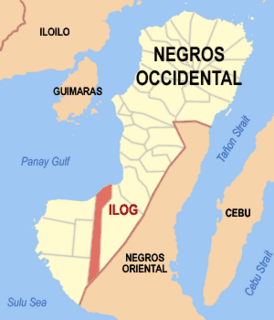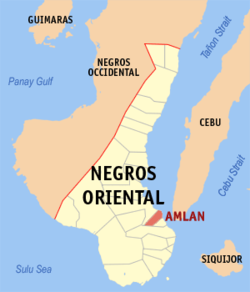
Ilog, officially the Municipality of Ilog, is a 2nd class municipality in the province of Negros Occidental, Philippines. According to the 2015 census, it has a population of 57,389 people.

Valencia, officially the Municipality of Valencia, is a 1st class municipality in the province of Negros Oriental, Philippines. According to the 2015 census, it has a population of 34,852 people.

Tanjay, officially the City of Tanjay or simply referred to as Tanjay City, is a 4th class city in the province of Negros Oriental, Philippines. According to the 2015 census, it has a population of 80,532 people.

Ayungon, officially the Municipality of Ayungon, is a 2nd class municipality in the province of Negros Oriental, Philippines. According to the 2015 census, it has a population of 46,303 people.

Basay, officially the Municipality of Basay, is a 4th class municipality in the province of Negros Oriental, Philippines. According to the 2015 census, it has a population of 26,566 people.

Bindoy, officially the Municipality of Bindoy, is a 3rd class municipality in the province of Negros Oriental, Philippines. According to the 2015 census, it has a population of 39,819 people.

Dauin, officially the Municipality of Dauin, is a 4th class municipality in the province of Negros Oriental, Philippines. According to the 2015 census, it has a population of 27,786 people.

Pamplona, officially the Municipality of Pamplona, is a 3rd class municipality in the province of Negros Oriental, Philippines. According to the 2015 census, it has a population of 37,596 people.

Zamboanguita, officially the Municipality of Zamboanguita, is a 4th class municipality in the province of Negros Oriental, Philippines. According to the 2015 census, it has a population of 27,552 people.

Silago, officially the Municipality of Silago, is a 4th class municipality in the province of Southern Leyte, Philippines. According to the 2015 census, it has a population of 12,775 people. It used to be barrio of Hinunangan until Executive Order No. 326 dated May 17, 1951 separated it from the mother town. The town has an ebony beach with unique black sand.

Cordova, officially the Municipality of Cordova,, is a 3rd class municipality in the province of Cebu, Philippines. According to the 2015 census, it has a population of 59,712 people.

Dumanjug, officially the Municipality of Dumanjug,, is a 3rd class municipality in the province of Cebu, Philippines. According to the 2015 census, it has a population of 51,210 people.

Malabuyoc, officially the Municipality of Malabuyoc,, is a 5th class municipality in the province of Cebu, Philippines. According to the 2015 census, it has a population of 19,373 people. Malabuyoc is situated in the southwestern coast of the island of Cebu and is about 125 kilometres (80 mi) from Cebu City.

Moalboal, officially the Municipality of Moalboal,, is a 4th class municipality in the province of Cebu, Philippines. According to the 2015 census, it has a population of 31,130 people.

Hinigaran, officially the Municipality of Hinigaran, is a 1st class municipality in the province of Negros Occidental, Philippines. According to the 2015 census, it has a population of 85,602 people.

Bien Unido, officially the Municipality of Bien Unido, is a 4th class municipality in the province of Bohol, Philippines. According to the 2015 census, it has a population of 27,115 people.

Catigbian, officially the Municipality of Catigbian,, is a 4th class municipality in the province of Bohol, Philippines. According to the 2015 census, it has a population of 22,675 people.

Tabina, officially the Municipality of Tabina, is a 4th class municipality in the province of Zamboanga del Sur, Philippines. According to the 2015 census, it has a population of 25,061 people.

Balangkayan,, officially the Municipality of Balangkayan, is a 5th class municipality in the province of Eastern Samar, Philippines. According to the 2015 census, it has a population of 10,125 people.

Saint Bernard, officially the Municipality of Saint Bernard, is a 4th class municipality in the province of Southern Leyte, Philippines. According to the 2015 census, it has a population of 28,395 people.

























